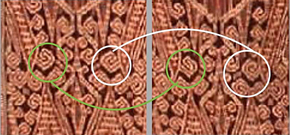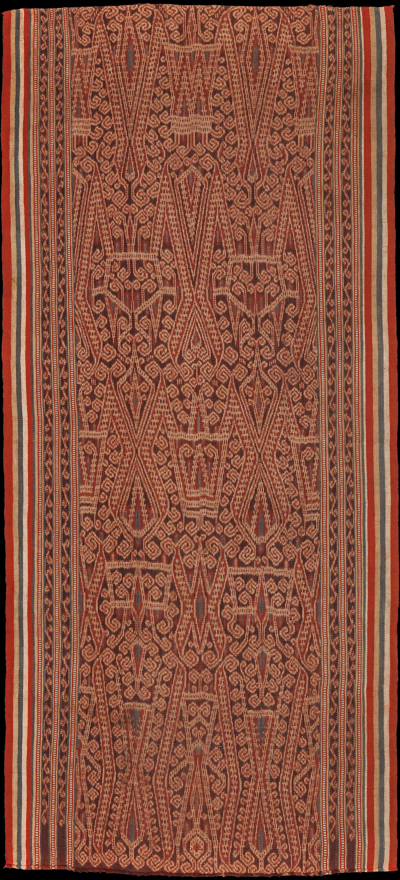| |
243 Borneo, Sarawak
Kain kebat (skirt cloth)  
|
| Locale: | Baleh river or tributary, 3rd Division. |
| Period: | 1920 of before |
| Yarn: | Cotton, hand-spun, medium |
| Technique: | Warp ikat |
| Panels: | 1 |
| Size: | 50.5 x 115 cm (1' 7" x 3' 9") LW: 2.28 |
| Weight: | 138 g (4.9 oz), 238 g/m2 (0.78 oz/ft2) |
| Design: | The Buah Rusa or Deer Pattern. The deer�s horn is depicted in this design. It normally appears on pua kumbu rather than on skirts and is a design woven by young apprentices. When it does appear on skirts, it denotes the work of an accomplished novice. Skirts with deer designs are rare because most of them were taken to the grave by their weavers. Numerous pale indigo accents further enliven the rich patterning. Although at first sight this kain kebat appears to have been made with a 4-fold replication, as John Cheah's analysis (see photo below) shows, it was actually made with only 2-fold replication. Both warp and weft are singly ply hand spun, two threads running in parallel. |
| Comment: | The level of intricacy puts this skirt on a par with the best Sarawak pieces. An intriguing feature is that the additional outer borders look like they were done in pre-dyed commercial thread - at the time considered a mark of wealth as its purchase involved monetary outlay � though in fact the weaver imitated such a luxury element by the use of natural indigo and morinda. This suggest provenance from an area subject to cultural influence from coastal tribes such as the Saribas, but living deeper in the interior, further from Chinese trading posts. Some slight smudging, largely limited to the borders, but otherwise in pristine condition. Colour intensity still very lively. |
| Background: | Chapters on Borneo and Sarawak. |
| Exhibited: | Hong Kong University Museum and Art Gallery, 2017. |
| Published: | Ikat Textiles of the Indonesian Archipelago, 2018.
|
| Compare: | 212 220 229 242 300 |
| Sources: | Similar kain kebat with Deer Pattern in Heppell, Iban Art, Plate 45; Khan Majlis, Textiles from Borneo, p. 78.; Ong, Woven Dreams, Ikat Textiles of Sarawak, p. 66, EO.9.
 |
| |

©Peter ten Hoopen, 2025
All rights reserved.
|


